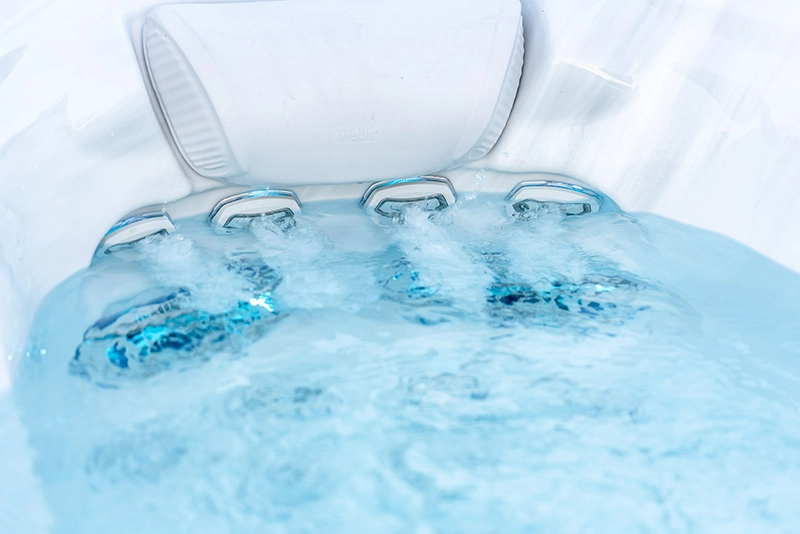Get the facts on Wellis hot tubs and energy efficiency. Discover cost savings and brand…

Most Energy Efficient Hot Tubs: A Guide to Choosing the Perfect One in 2023
Find the most energy efficient hot tubs and learn how you can choose the one perfect for you.
Are you considering buying a hot tub, but concerned about the energy costs? With rising electricity bills, it’s important to choose hot tubs that are energy efficient. But with so many options on the market, it can be overwhelming to know where to start.
In this article, we’ll explore what makes a hot tub energy efficient and provide hot tub facts and tips on how to choose the most efficient one for your needs. We’ll also highlight three of the most energy-efficient hot tubs that we offer, so you can make an informed decision and enjoy your hot tub without breaking the bank.
Let’s dive in!

What Are The Most Energy-Efficient Hot Tubs?
There are a few factors to consider when choosing the most energy-efficient hot tub. The first is the size of the tub. A smaller hot tub will use less energy than a larger one. The second factor is the type of heating system. Electric heaters are more energy-efficient than gas heaters. The third factor is insulation. A well-insulated hot tub will retain heat better and use less energy to maintain the desired temperature.
When it comes to size, a small, well-insulated hot tub that holds two to three people is the most energy-efficient option. If you have a larger family or entertain often, then a medium or large hot tub would be more suitable.
Popular hot tub amenities include jets, lounge chairs, and foot massagers. Another crucial “feature” to take into account when purchasing a hot tub is the cost of operation. A more expensive hot tub could include complete foam insulation, a tight-fitting cover to hold the water temperature and other energy-efficient features.
The hot tub will, however, be less expensive to run over time. In the long run, you will save more money by purchasing a more expensive hot tub. It might seem like a big chunk of money to give at once, but when you do the energy calculation of enjoying this luxury at less cost, it is worth it.
So, in essence, quality construction and building materials, full foam insulation, and a snug-fitting cover that is designed to keep in heat constitute an energy-efficient hot tub.
The Importance of Energy Efficiency in Hot Tubs
Energy efficiency is important for many reasons when it comes to hot tubs. For one, it can save you money on your energy bills. It can also help to prolong the life of your hot tub and make it more efficient overall. Additionally, energy efficiency can help to reduce your carbon footprint and impact on the environment.
When choosing a hot tub, there are a few things you can do to ensure that you are getting an energy-efficient model. First, look for a model that is certified by the EPA or another similar organization. This certification means that the hot tub has been tested and proven to be energy-efficient. Second, check the EnergyGuide label on the hot tub. This label will give you an estimate of how much the hot tub will cost to operate each year. Ask your hot tub dealer about any energy-saving features that their models offer.
When a hot tub follows stringent energy guidelines, together with its efficient equipment, the monthly energy cost gets lower. That means that you don’t need to keep the water warm, you can enjoy hot water and save money, too.
The Benefits of Owning an Energy-Efficient Hot Tub
Modern hot tubs use less energy to keep the water at the desired temperature than they would if they had to reheat the entire tub every time it was used. Instead of water cooling down every time you finish soaking, a modern hot tub can save energy by keeping the heat from the water in (with a cover for example) and only heating it up to your desired water temperature when you are ready to use it again.
Understanding Energy Efficiency in Hot Tubs
There are three key factors to consider when choosing the most energy-efficient hot tub: insulation, pump and heater efficiency, and cover quality.
Hot Tub Insulation
A hot tub’s insulation plays a big role in its energy efficiency. Well-insulated hot tubs retain heat better, meaning the pump and heater won’t have to work as hard (and use as much energy) to maintain the water temperature. Look for a hot tub with thick walls and a good seal around the door or lid.
Pump and Heater Efficiency
The pump and heater are the two biggest energy users in a hot tub. Look for models with high-efficiency pumps and heaters that use less electricity to operate.
Cover Quality
A good hot tub cover helps retain heat and protects against weather damage when not in use. Be sure to choose a cover that fits snugly on your hot tub and is made of durable material that will last for years.
Hot Tub Energy Consumption Ratings
When it comes to energy efficiency, all hot tubs are not created equal. In fact, there can be a big difference in the amount of energy that different models use. That’s why it’s important to check the energy consumption ratings of any hot tub you’re considering before making a purchase.
In terms of specific energy consumption ratings, you’ll want to look for a model that has an Energy Star rating. This means that it meets strict guidelines set by the US Environmental Protection Agency (EPA) for energy efficiency. Models with this rating will use less electricity than those without it, so you’ll save money on your running cost of a hot tub in the long run.
Hot tubs with higher Energy Star ratings are more efficient and will cost less to operate. If you’re looking for the most energy-efficient hot tub, look for one with an Energy Star rating of 3 or above.
When comparing different models, make sure to look at their annual operating costs as well as their initial purchase price. The initial cost may be higher for an Energy Star-rated hot tub with superior energy efficiency, but its lower operating costs will save you money over time. Choose the model that makes the most financial sense for you and your family in the long run.
Energy-Efficient Hot Tub Technologies
When it comes to energy efficiency, there are a few features that you should look for in a hot tub. Let’s discuss some of them down below:
Advanced Insulation Materials
Advanced insulation materials are key to maintaining the heat in your hot tub. There are many options on the market, but not all of them are created equal.
Polyurethane foam insulation is one of the most popular options for hot tubs. It is effective at keeping the heat in and is also very affordable. The dense foam core and foam design will help keep the spa water hot.
Another option is closed-cell spray foam insulation. This type of insulation is slightly more expensive than polyurethane foam, but it is even more effective at keeping the heat in. A hot tub can even have foam on the entire interior of the spa structure, making it an ultra-energy-efficient foam.
Variable Speed Energy Efficient Hot Tub Pump
If you’re looking for an energy-efficient hot tub pump, a variable-speed model is a great option. These pumps can operate at different speeds, which means they use less energy when the hot tub isn’t in use. Additionally, variable speed models are often quieter than other types of pumps.
Energy-Efficient Hot Tub Heater
There are two main types of heaters: gas and electric. Gas heaters are more efficient than electric heaters, but they can be more expensive to operate. Electric heaters are less expensive to operate, but they are not as efficient as gas heaters.
Automated Covers and Heat Retention
One of the most important features to look for in an energy-efficient hot tub is an automated cover. A good cover will help to keep the heat in, which means that your hot tub will use less energy to maintain the temperature you want.
How to Choose an Energy-Efficient Hot Tub
In order to be absolutely sure that you choose the hot tub for your family, which will also be energy efficient, you need to consider several things on your checklist. So, as we mentioned before, you need to evaluate your specific needs. Smaller families require smaller hot tubs as not many of you will use it at the same time. However, if you have a large extended family that you like to entertain, you might benefit from a larger swim spa energy efficient, of course.
Another thing to keep in mind is the budget. Hot tubs and swim spas can get pricey, so you need to be aware of how much you can spend so that you don’t get carried away with the glitz and glamour of hot tubs on the shop’s floor. Make sure the salesperson is aware of your budget limitations (both initial and monthly) so that they can adequately help you.
When you’ve discussed the budget, you need to know where your new hot tub will go. Depending on the location and the space available, you’ll be able to choose something that is well thought through and not bought on a whim only to be an eyesore later on.
Last but not least, compare energy consumption ratings and use the energy calculator to get an idea of what individual energy consumption will be.
Extra Tips for Maximizing Hot Tub Energy Efficiency
To keep your new hot tub energy efficient and working for longer, you’ll need to be a devoted user. You’ll need to do proper maintenance on the hot tub, like:
- Check the water balance twice a week
- Use bromine or chlorine for hot tub
- Clean the filter twice a month
- Every three to four months, clean, drain, and refill the spa
- The spa cover should be aired twice a week
- For the spa to stay full, add water as needed
Seasonal adjustments are also necessary. You don’t want to be overheating the hot tub during the summer, so the water temperature should be set at around 85 degrees Fahrenheit. Although the ideal water temperature for a hot tub is anywhere between 100-102 degrees Fahrenheit (with 104 degrees being the maximum it can go), you can keep it at around 97-99 degrees Fahrenheit in the winter. As it is cool outside, the water will need more time to heat up. As for the ‘How long does a hot tub last?’ question, that entirely falls on proper maintenance.
Summary
With the right information and research, you now know how to choose a hot tub that is the most energy-efficient in 2023. You should take into consideration factors such as size, features, cost, warranty coverage, and of course energy efficiency when making your decision. Utilizing this guide as a starting point is an excellent way to narrow down your choices and find the perfect energy efficient hot tubs for sale that will fit both your lifestyle and budget!
Frequently Asked Questions (FAQs)
Depending on the model and the size, hot tubs vary in energy efficiency. Wellis’ hot tubs spend approximately 0.25 kWh, which is the most energy-efficient hot tub on the market currently.
weekly usage of 3–4 hours in your hot tub might result in an additional 100–120 Kilowatts. In order to maintain consistent heating, this entails using your hot tub continuously at least three to four times each week. If the system is allowed to cool, it will take more energy to heat it back up than if it is maintained at a constant temperature.
The smartest way you can run a hot tub is to keep the water temperature at no lower than 88 degrees Fahrenheit with a tight cover, and only to heat up to 100 when you want to use it.
In general, hot tubs can use from 75-180 kWh monthly. Of course, the usage will depend on the factors like outside temperature, the hot tub’s insulation, the water temperature, the age of the water pump and heater, and the number of hours you’ll run it.
An energy-efficient hot tub can use as little as 3 kWh a day for a five seater. It depends on how much you use it, the size of the hot tub itself, the pump and the water heater, as well as hot tub’s insulation. Other factors include the outside temperature

Interested in a Hot Tub in North Carolina?
We have two showrooms in NC, including one in Raleigh and one in Durham. Call 888-884-3742 or Fill Out the Form Below to Contact Us Today
Manny Brambila
Manny has been in the Pool & Spa industry for over 15 years and is considered a pool, swim spa, & hot tub expert. He has been a Certified Pool & Spa Operator (CPO) since 2009 and worked 15 years in aquatic training and development for the largest pool chemical and customer care company. He also has been an outside consultant for the Pool and Spa industry in Chicago, New York and Los Angeles since 2018. In the past few years Manny has become Director of Operations for Epic Hot Tubs with a priority of providing customers with the most reliable information and best service possible.


